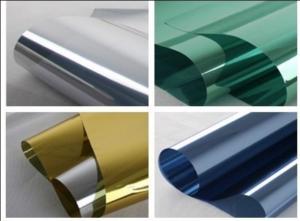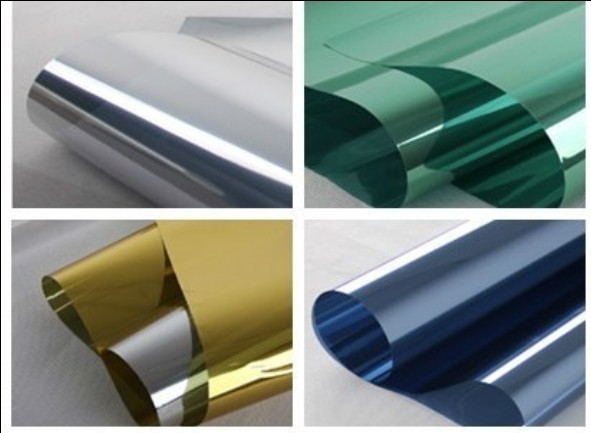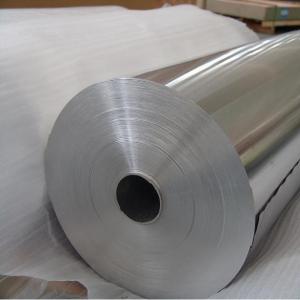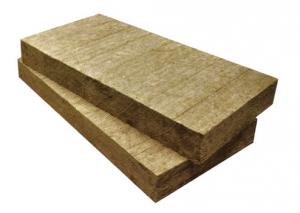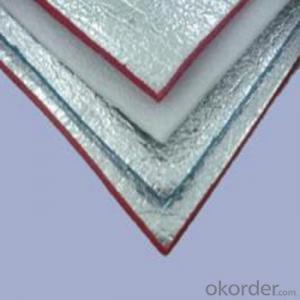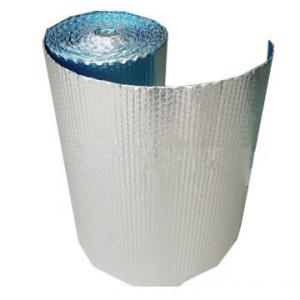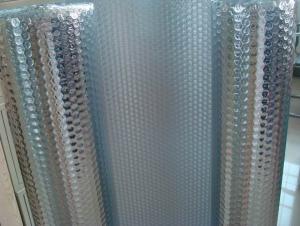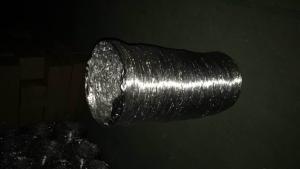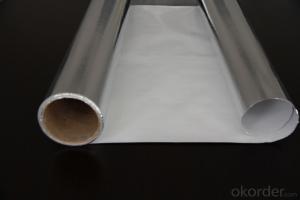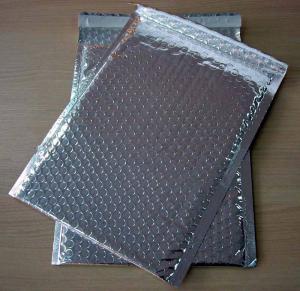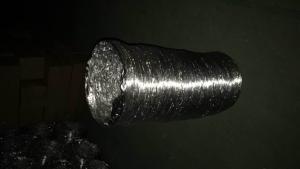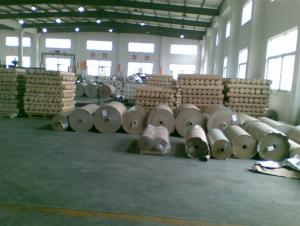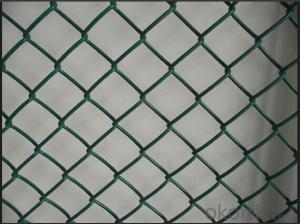Aluminum Foil Facing Single Side Aluminum Foil with LLDPE
- Loading Port:
- China Main Port
- Payment Terms:
- TT OR LC
- Min Order Qty:
- -
- Supply Capability:
- -
OKorder Service Pledge
Quality Product, Order Online Tracking, Timely Delivery
OKorder Financial Service
Credit Rating, Credit Services, Credit Purchasing
You Might Also Like
Material Structure: AL/2 way scrim/Paper | ||
Paper Weight:60gsm ( Standard, can be Customized) | ||
Roll Size:1.2m*50m ,1.25*50m (can be customized) | ||
PROPERTIES | TEST DATA | UNIT |
Thickness | +-0.15 | mm |
Weight | +-110 | gsm |
Emissivity | 0.03-0.04 | COEF |
Thermal conductivity | 0.037 | w/m0 |
Bursting Strength | 90 | N/25mm |
Reflectivity | 96-97 | % |
Water Vapour Transmission | 1.15 | Ng/N.S |
Corrosion | doesn't generate | |
Tensile Strength(MD) | 144.4 | N/25mm |
Tensile Strength(TD) | 46.3 | N/25mm |
- Q: The user is asking if they can reuse their old aluminum foil facing to create new ones once it becomes worn out.
- <p>No, you cannot create new aluminum foil facings from old, worn-out ones. Aluminum foil facings are typically made from a specific type of aluminum that is bonded to a substrate. Once it wears out, the aluminum layer is compromised and cannot be reused to make new facings. Recycling old aluminum foil is the best option to reduce waste and conserve resources. You can recycle aluminum foil, which will then be processed and turned into new aluminum products.</p>
- Q: What are the alternatives to using aluminum foil for food packaging?
- <p>Yes, there are several alternatives to aluminum foil for food packaging. These include biodegradable materials such as plant-based films, paper-based packaging, and compostable plastics. There are also reusable silicone food wraps and beeswax wraps that can be used multiple times. Additionally, glass and stainless steel containers are excellent alternatives for food storage and can be used instead of aluminum foil for certain applications. These alternatives not only reduce waste but also contribute to a more sustainable environment.</p>
- Q: What are the distinctions among various food wraps found in stores?
- <p>Yes, there are differences among food wraps available on the market. They vary in material, such as plastic, aluminum foil, parchment paper, and beeswax wraps. Each type has distinct properties: plastic cling wrap is versatile but not microwave-safe; aluminum foil conducts heat well and is reusable but can tear easily; parchment paper is ideal for baking and can withstand high temperatures; and beeswax wraps are eco-friendly, reusable, and can be used in the fridge or freezer but not for high-heat cooking. Each type also differs in terms of environmental impact, cost, and suitability for different food storage and cooking needs.</p>
- Q: Is it safe and effective to use aluminum foil facing material for wrapping rice for storage purposes?
- <p>Using aluminum foil facing to wrap rice for storage is not recommended. Aluminum foil facing is not designed for food contact and may contain chemicals that could contaminate the rice. Instead, opt for food-grade materials like plastic bags or containers specifically designed for food storage. These materials are safer and help maintain the freshness and quality of the rice.</p>
- Q: Is inhaling aluminum oxide particles from aluminum foil dangerous to health?
- <p>Breathing in aluminum oxide particles is generally not harmful in small amounts, as the human body can handle trace amounts of aluminum. However, prolonged exposure to high concentrations of aluminum oxide dust can cause respiratory issues and may have potential health risks. It is always advisable to handle aluminum foil and other materials that could generate dust in a well-ventilated area to minimize the risk of inhalation.</p>
- Q: Describe the most effective methods for utilizing aluminum foil in cooking.
- <p>Aluminum foil facing can be used effectively in cooking in several ways: 1) As a barrier to prevent food from sticking to the pan or grill, reducing the need for oil or butter. 2) To wrap foods for steaming, which helps retain moisture and flavor. 3) As a cover to keep food warm after cooking or to prevent overcooking. 4) To create packets for cooking fish, vegetables, or other foods en papillote, which steams the food in its own juices. 5) For baking, it can be used to line pans to prevent sticking and to make cleanup easier. 6) Foil can also be shaped into a tent to cover food during the last few minutes of cooking to prevent it from drying out. Always ensure the shiny side of the foil faces inwards when in contact with food to avoid any potential chemical reactions with the food.</p>
- Q: Is it safe and effective to use aluminum foil with a reflective side to wrap vegetables when grilling?
- <p>Yes, you can use aluminum foil facing to wrap vegetables for grilling. Aluminum foil helps to retain moisture and heat, ensuring that the vegetables cook evenly and remain tender. The reflective side of the foil can also help to distribute heat more evenly. However, be cautious not to let the foil touch the flame directly, as it can cause flare-ups. Make sure to poke some holes in the foil to allow steam to escape and prevent the vegetables from becoming too soggy.</p>
- Q: This question asks for instructions on how to store food wrap materials after they have been used.
- <p>After using food wrap materials, it's important to clean them properly before storing. Rinse off any food residue with warm water and mild dish soap. Avoid using abrasive materials that could damage the wrap. Once clean, gently pat dry with a clean towel or let air dry. Store the wraps in a cool, dry place away from direct sunlight to prevent degradation. You can use a clean, airtight container or resealable plastic bag to keep them protected and dust-free. Always check for any signs of wear or damage before reusing to ensure food safety.</p>
- Q: Can aluminum foil be used as a surface for making pizza crust?
- <p>Yes, you can use aluminum foil facing to make a pizza crust. It's a convenient and non-stick surface that allows the crust to bake evenly and prevents it from sticking. Simply prepare your pizza dough and place it on a piece of aluminum foil sprayed with cooking oil or lined with a silicone mat. Bake according to your pizza recipe, and the aluminum foil will help create a crispy crust.</p>
- Q: How should one properly clean and store aluminum foil facing after usage to maintain its quality and hygiene?
- <p>The best way to clean your aluminum foil facing after use is to gently wipe it with a damp cloth to remove any residue. Avoid using abrasive materials as they can scratch the surface. After cleaning, let it dry completely. To store, roll it up tightly or fold it neatly, and keep it in a cool, dry place away from direct sunlight to prevent any damage or discoloration. Use a resealable plastic bag or a designated container to protect it from dust and moisture.</p>
Send your message to us
Aluminum Foil Facing Single Side Aluminum Foil with LLDPE
- Loading Port:
- China Main Port
- Payment Terms:
- TT OR LC
- Min Order Qty:
- -
- Supply Capability:
- -
OKorder Service Pledge
Quality Product, Order Online Tracking, Timely Delivery
OKorder Financial Service
Credit Rating, Credit Services, Credit Purchasing
Similar products
Hot products
Hot Searches
Related keywords
